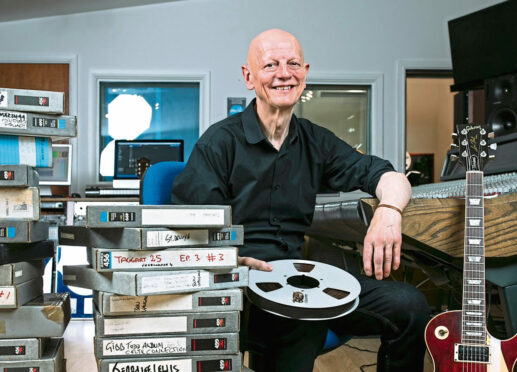
When Fran Healy turned up unannounced, Duncan Cameron thought the Travis frontman had brought him a pizza.
“It had been a long day and I was in the middle of something when Fran put his head round the door,” Cameron remembers. “I remember saying, ‘Jeez, how did you know we were hungry?’”
But it was 1999, and the flat cardboard box actually contained a gold disc to mark Cameron’s work on The Man Who – the band’s second album, which had just sold 100,000 copies – and would later clock up sales of 3.5 million worldwide.
“I was blown away. We’d demo’d the album for Travis but it was the last thing I was expecting.”
Cameron has spent 32 years in the business running Riverside Studios in Busby, near Glasgow, with his brother Johnny. Assisted by engineer David McClean, they’ve built up a client list that reads like a who’s who of popular music.
Their tape store is packed full of master recordings of artists including Jerry Lee Lewis, Big Country, Teenage Fanclub, BMX Bandits, Shane MacGowan, Del Amitri, Ian Brown, the Military Wives Choir and the Scottish Chamber Orchestra.
“We’re nothing if not versatile. There are 32 years of recording history in that store. And I can still remember every single session,” said Cameron.
The brothers started out in rock bands with their elder brother Wallace signing to Warner Chappell Music in 1978 as Sneeky Pete and later to Atlantic Records as The Force in 1986.
“We toured for 15 years right through the 70s to the mid 80s,” explained Cameron, who has two grown-up sons, Jamie and Ross and a daughter, Laura.
“We decided to open a studio so we would have a place to record our second album for Atlantic but life just took over.”
The first Riverside opened in 1990 in a converted cottage on the banks of the White Cart. It later moved half a mile to its current location, an old mill building, in 2004. Nowadays the studio also operates as an educational facility offering HNC, HND and degree courses to students entering the industry.
“We were right at the start of the indie rock boom and a lot of the bands were signed to labels like Alan McGee’s Creation Records,” explained Cameron. “There was a huge gap in the market for that style of recording.
“We invested in a 60-channel mixing desk which at the time cost £200,000 and it set us apart. We made an unbelievable number of records for artists who were starting to break through.”
Travis were just starting out when they demoed The Man Who at Riverside in 1998. “When they came to record, they didn’t have much money or much of their own gear,” said Cameron.
“So, most of the gear we used on the recording of The Man Who belonged to Teenage Fanclub. It’s funny when you think about it now. But everybody just used to muck in.”
Cameron first met Teenage Fanclub when he supplied PA for their early gigs in the Hattonrigg Hotel in Bellshill, Lanarkshire.
“They started to record mostly EPs and singles with us from the early 90s onwards,” he explained.
He also recorded with rock and roll legend Jerry Lee Lewis in 2000 although the rocker nicknamed The Killer didn’t travel to the southside of Glasgow.
“Jerry Lee recorded piano and vocals in the States and sent them down the line to us.
“We recorded the additional music, with Francis MacDonald’s band Radio Sweethearts, mixed it and sent it back to him.
“It was great fun to do.”
But a mix-up meant Cameron failed to get a writing credit on a song recorded by Pogues’ frontman Shane MacGowan.
“Shane and Glasgow producer Phil Ferns had written a song, Road to Paradise, for Lord of the Wing, a film about Jimmy Johnstone,” he explained.
“But Shane had gone off it by the time he started recording it. So, the band were sent to the pub and Shane, Phil and I rewrote the song.
“They came back and we recorded it through the night.”
Cameron was delighted when MacGowan insisted he receive a credit.
But he said: “The names of the writers – Shane MacGowan, Phil Ferns and D Cameron – were given over the phone.
“But the guy on the other end took down Andy Cameron.
“So, Andy Cameron has a writing credit on Shane MacGowan’s Road to Paradise. You couldn’t make it up.”
Cameron, who is 70 in February, has no intention of retiring and has just finished a new album for Glasgow-based hard rock band Mason Hill.
“Looking back, it’s great to be a part of other people’s success.
“In a way, that’s what makes you have your own success.”

Enjoy the convenience of having The Sunday Post delivered as a digital ePaper straight to your smartphone, tablet or computer.
Subscribe for only £5.49 a month and enjoy all the benefits of the printed paper as a digital replica.
Subscribe